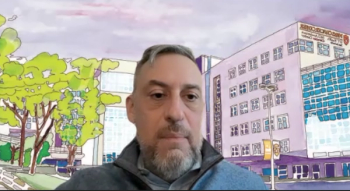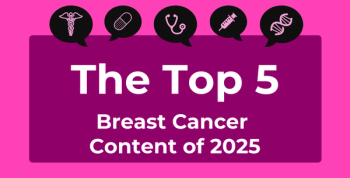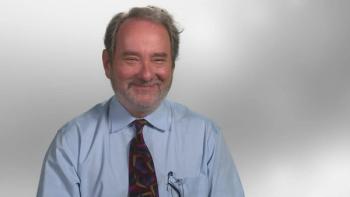The antibody-drug conjugate (ADC) trastuzumab deruxtecan (Enhertu; AstraZeneca/Daiichi Sankyo) has provided a new treatment option for thousands of patients with HER2+ breast cancer.1-3 Yet questions remain about the drug’s association with interstitial lung disease (ILD), which is seen in many cancers but can cause death in patients treated with this otherwise groundbreaking therapy.4
The consequences for patients with HER2+ breast cancer are such that guidelines call for stopping trastuzumab deruxtecan (T-Dxd) for good if grade 2 ILD appears.4,5 For those with grade 1 ILD, retreatment is possible, but data have been limited on how patients fare after restarting the ADC.
In the past year, a pair of studies have shed light on patients who are rechallenged with T-Dxd following recovery from ILD,6,7 with the second study presented May 30, 2025, during the American Society of Clinical Oncology (ASCO) annual meeting.7 Data from the first study were presented at the 2024 European Society for Medical Oncology (ESMO) annual meeting in Barcelona, Spain.6 The second study, involving real-world evidence (RWE) for patients from 5 institutions treated from 2017 to 2024, was presented by Hope S. Rugo, MD, recently named division chief of breast medical oncology and professor of medical oncology and therapeutics research at City of Hope. Rugo also serves as director of the Women’s Cancers Program for City of Hope’s national network of cancer centers8 is a professor emeritus of UCSF.
Breast Cancer Forum Moves to City of Hope
Hope S. Rugo, MD, who in April became division chief of breast medical oncology and professor of Medical Oncology and Therapeutics Research at City of Hope, on Monday will relaunch her successful education program, the virtual Breast Cancer Forum. This approach allows breast cancer oncologists to discuss the implications of data recently presented at major professional meetings, such as ASCO, the European Society for Medical Oncology or the San Antonio Breast Cancer Symposium.
On Monday, June 16, 2025, Rugo will lead a post-ASCO Breast Cancer Forum featuring faculty from City of Hope and special guest Joyce O’Shaughnessy, MD, who is co-chair Breast Cancer Research and Chair of Breast Cancer Prevention Research at Baylor-Sammons Cancer Center and for The US Oncology Network.
City of Hope faculty joining the program are: Jose Bazan, MD, MS, director of Breast Radiation Oncology and associate professor, Department of Radiation Oncology; Irene M. Kang, MD, medical director of women’s health medical oncology and assistant professor, Department of Medical Oncology & Therapeutics Research; Cindy Chou Tran, DO, associate clinical professor, Department of Medical Oncology and Therapeutics Research; and Katharine Schulz-Costello, DO, breast surgeon assistant clinical professor, Division of Breast Surgery, Department of Surgery.
The virtual forum will run from 5 to 6:30 p.m. PT / 8 to 9:30 ET. The program is free but RSVP is required. Visit here to register.
The American Journal of Managed Care® spoke with Rugo following her presentation at ASCO. She offered context on the emergence of ILD, both among the overall population of patients with breast cancer and specifically among those patients with HER2+ breast cancer treated with T-Dxd. Taken together, results from the studies show that patients who recover from grade 1 ILD can be successfully retreated with T-Dxd, and that some patients can stay on therapy for months. The challenge now, Rugo said, is learning which patients are likely to develop high-grade ILD and to halt that process. “We don't really understand why some people's ILD rapidly progresses to ILD that is fatal,” she said. “That is a big area of research moving forward.”
Pioneering Therapy—With a Dangerous Adverse Effect
Like other therapies in its class, T-Dxd combines the best features of targeted therapy and chemotherapy by delivering a powerful, cytotoxic “payload” directly to cancer calls. The monoclonal antibody binds to the protein being targeted, while a “linker” connects the antibody and the drug. However, T-Dxd has proven to be a standout among ADCs. In 2022, the DESTINY-Breast03 trial showed a 72% reduced risk of disease progression or death compared with a different ADC, trastuzumab emtansine (Kadcyla; Roche), in patients previously treated for HER2+ metastatic breast cancer.1 More recent trials showed T-Dxd offered benefits even when levels of HER2 expression are lower than what is historically considered HER2+.2,3
Rugo points out that ILD has been seen with many cancer therapies and does not occur in all patients treated with T-Dxd—only 11% to 15%. “We see grade 1 ILD with a number of different drugs—even at a very low rate from the prior antibody-drug conjugate that was our go-to for HER2+ positive breast cancer, which was [trastuzumab emtansine],” she said.
“Notably, we see low rates of grade 1 ILD with CDK4/6 inhibitors, which are used in a very broad population, in everolimus (Afinitor), as well as other drugs,” she continued. “But we hadn’t worried about grade 1 ILD at all before, because patients had it and it went away.” When patients had more serious ILD cases, it was manageable.
T-Dxd was different. It was first studied in Japanese patients, who had higher rates of drug-related ILD. “When we started testing it in different dose levels, there were patients who died, unfortunately, of interstitial lung disease,” Rugo said. Patients became “very symptomatic, short of breath, and as it progressed, it couldn't be rescued back.”
She said additional research produced 2 key developments: Investigators lowered the dose for phase 3 studies of T-Dxd, because ILD was clearly dose dependent. Second, they developed better ways to spot ILD as early as possible, “to try and avoid progression to higher-grade ILD.”
Fatal ILD has declined in clinical trials, but it has not disappeared: In the 2019 DESTINY-Breast01 trial, 4 patients (2%), experienced fatal ILD9; results for DESTINY-Breast09, presented last month and evaluating T-Dxd in newly diagnosed patients, showed 2 deaths (0.9%).10
Rugo believes something about the way T-Dxd targets HER2 causes ILD to be more dangerous that previously seen. She points to examples of ADCs for other targets that don’t cause such severe ILD, such as TROP2, the target for sacituzumab govitecan (Trodelvy; Gilead), which treats HR+, HER2– metastatic breast cancer; Rugo was the lead investigator for TROPiCS-02, which led to FDA approval for sacituzumab govitecan in this indication.11
And, she noted that data for HER3-DXd, an ADC also called patritumab deruxtecan that targets HER3, don’t show the same degree of ILD.12
Results Presented at ASCO
Rugo’s presentation at ASCO helped fill an important knowledge gap: What happens in real-world settings if patients who stop T-DXd after experiencing ILD restart the therapy?
The study identified patients with ILD through chart reviews and confirmation of International Classification of Diseases codes. Investigators collected patient demographics, imaging results, information on steroid dosing, and patient outcomes after retreatment, or “rechallenge” with T-Dxd. Four centers provided information on 712 patients treated with T-Dxd, with 65 patients (9.1%) who experienced ILD of any grade. One other center reported on data on rechallenge outcomes for 18 patients with ILD.7
The analysis showed the following:7
- A total of 47 patients were rechallenged; this included 38 patients after grade 1 ILD and 9 patients after grade 2. Of this group, 91% were treated for breast cancer.
- The median time to initial ILD was 145 days after the first dose (IQR, 78-205).
- Among 50 patients with grade 1 ILD, including those patients not rechallenged, 28 of 50 (56%) received steroids, for a median of 36 days (IQR, 27-79).
- Radiographic improvement was seen at a median of 24 days (IQR 19-63) for patients treated with steroids, compared with 82 days (IQR, 48-94) for those without steroids (P < .01), and a median of 35 days (IQR, 22-82) for patients who were rechallenged, compared with 81 days (IQR, 68-105) for patients who were not rechallenged (P = .01).
- Among pts with grade 1 ILD, 38 of 50 patients (76%) were rechallenged at a median of 42 days (IQR, 36-57) from their last dose of T-Dxd; 23 of 38 (61%) were dose reduced.
- After being rechallenged with T-Dxd, patients stayed on therapy for a median of 215 days (IQR, 60-334), with 10 of 38 (26%) developing recurrent ILD. Of those developing recurrent ILD, 7 patients had grade 1, 2 had grade 2, and 1 had grade 3, occurring at a median of 211 days (IQR, 47-273).
- Of the 9 patients with grade 2 ILD, therapy was continued for a median of 129 days (IQR, 49-171), and 2 of the 9 patients developed recurrent ILD (1 grade 2, 1 grade 3).
- No fatal cases of ILD were seen after rechallenge with T-Dxd.
Of note, investigators found no statistically significant differences in demographics for ILD onset, time to rechallenge, or patients with recurrent ILD. The data highlight the need for early use of steroids, as patients treated with steroids recovered in less than half the time of patients who did not receive steroids.7
Rugo outlined the precise scheduling she follows if grade 1 ILD appears, designed to get patients back on therapy as quickly as possible. “We usually get scans before a drug dose is due. If the scan shows grade 1 ILD, you start the steroids [and] skip that dose. Then, 3 weeks later, you’ll want to have another scan so that you can get the next treatment on schedule.” In total, this will result in a 6-week break between doses.
Although there were patients with grade 2 ILD in this study, Rugo does not recommend any change in the guidelines. “We need to be ultra safe,” she said. Although T-Dxd is the most effective ADC studied, there are others that are effective. And, she said, it’s important to be sure that grade 2 ILD is drug related.
Rugo said it’s especially important to be cautious given the results for DESTINY-Breast09. “As we move the drugs earlier into the course of treatment, we definitely do not want to shorten life or cause significant disability.”
References
- Cortes J, Kim SB, Chung WP, et al; DESTINY-Breast03 trial investigators. Trastuzumab deruxtecan versus trastuzumab emtansine for breast cancer. N Engl J Med. 2022;386(12):1143-1154. doi:10.1056/NEJMoa2115022
- Modi S, Jacot W, Yamashita T, et al; DESTINY-Breast04 trial investigators. Trastuzumab deruxtecan in previously treated HER2-low advanced breast cancer. N Engl J Med. 2022;387(1):9-20. doi:10.1056/NEJMoa2203690
- Bardia A, Hu X, Dent R, et al; DESTINY-Breast06 trial investigators. Trastuzumab deruxtecan after endocrine therapy in metastatic breast cancer. N Engl J Med. 2024;391(22):2110-2122. doi:10.1056/NEJMoa2407086
- Swain SM, Nishino M, Lancaster LH, et al. Multidisciplinary clinical guidance on trastuzumab deruxtecan (T-DXd)-related interstitial lung disease/pneumonitis-Focus on proactive monitoring, diagnosis, and management. Cancer Treat Rev. 2022;106:102378. doi:10.1016/j.ctrv.2022.102378
- de Weger VA, Schutte T, Konings IRHM, Menke-van der Houven van Oordt CW. Successful trastuzumab-deruxtecan rechallenge after interstitial lung disease: a case report. J Breast Cancer. 2023;26(5):519-523. doi:10.4048/jbc.2023.26.e38.
- Natsuhara KH, Vella M, Behr SC, et al. 381P treatment rechallenge after grade 1 trastuzumab-deruxtecan related interstitial lung disease: a real-world experience. Ann Oncol. 2024;35(2):Abstract S378.
- Natsuhara KH, Blum K, LeVee AA, et al. Treatment rechallenge after trastuzumab-deruxtecan–related interstitial lung disease: a multi-institution cohort study. J Clin Oncol. 2025;43(suppl 16):1015. doi:10.1200/JCO.2025.43.16_suppl.1015
- Renowned breast cancer physician scientist Hope S. Rugo, MD, to lead City of Hope’s Women’s Cancers Program. BusinessWire. April 16, 2025, Accessed June 15, 2025. https://bwnews.pr/45qmd2K
- Modi S, Saura C, Yamashita T, et al; DESTINY-Breast01 trial investigators. Trastuzumab deruxtecan in previously treated HER2-positive breast cancer. N Engl J Med. 2020;382(7):610-621. doi:10.1056/NEJMoa1914510
- Tolaney SM, Jiang Z, Zhang Q, et al. Trastuzumab deruxtecan (T-DXd) ± pertuzumab (P) vs taxane + trastuzumab + pertuzumab (THP) for first-line (1L) treatment of patients (pts) with human epidermal growth factor receptor 2–positive (HER2+) advanced/metastatic breast cancer (a/mBC): primary results from DESTINY-Breast09. J Clin Oncol. 2025;43(suppl 17):Abstract LBA1008.
- Rugo HS, Bardia A, Marme F, et al; TROPiCS-02 study investigators. Sacituzumab govitecan in hormone receptor–positive/human epidermal growth factor receptor 2–negative metastatic breast cancer. J Clin Oncol. 2022;40(29):3365-3376. doi:10.1200/JCO.22.01002
- O’Shaugnessy J, Collins JM, Yao L, et al. A phase 2, randomized, open-label study evaluating neoadjuvant patritumab deruxtecan + pembrolizumab before or after pembrolizumab + chemotherapy for early-stage TNBC or HR-low+/HER2− breast cancer. J Clin Oncol. 2025;43(suppl 16):Abstract TPS629. doi:10.1200/JCO.2025.43.16_suppl.TPS629










































